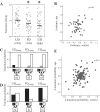Predicting plasticity: acute context-dependent changes to vocal performance predict long-term age-dependent changes
- PMID: 26311186
- PMCID: PMC4609757
- DOI: 10.1152/jn.00688.2015
Predicting plasticity: acute context-dependent changes to vocal performance predict long-term age-dependent changes
Abstract
Understanding the factors that predict and guide variation in behavioral change can lend insight into mechanisms of motor plasticity and individual differences in behavior. The performance of adult birdsong changes with age in a manner that is similar to rapid context-dependent changes to song. To reveal mechanisms of vocal plasticity, we analyzed the degree to which variation in the direction and magnitude of age-dependent changes to Bengalese finch song could be predicted by variation in context-dependent changes. Using a repeated-measures design, we found that variation in age-dependent changes to the timing, sequencing, and structure of vocal elements ("syllables") was significantly predicted by variation in context-dependent changes. In particular, the degree to which the duration of intersyllable gaps, syllable sequencing at branch points, and fundamental frequency of syllables within spontaneous [undirected (UD)] songs changed over time was correlated with the degree to which these features changed from UD song to female-directed (FD) song in young-adult finches (FDyoung). As such, the structure of some temporal features of UD songs converged over time onto the structure of FDyoung songs. This convergence suggested that the FDyoung song could serve as a stable target for vocal motor plasticity. Consequently, we analyzed the stability of FD song and found that the temporal structure of FD song changed significantly over time in a manner similar to UD song. Because FD song is considered a state of heightened performance, these data suggest that age-dependent changes could reflect practice-related improvements in vocal motor performance.
Keywords: Bengalese finch; birdsong; sequencing; social context; tempo.
Copyright © 2015 the American Physiological Society.
Figures





Similar articles
-
Relationship between the Sequencing and Timing of Vocal Motor Elements in Birdsong.PLoS One. 2015 Dec 9;10(12):e0143203. doi: 10.1371/journal.pone.0143203. eCollection 2015. PLoS One. 2015. PMID: 26650933 Free PMC article.
-
Developmental modulation and predictability of age-dependent vocal plasticity in adult zebra finches.Brain Res. 2019 Oct 15;1721:146336. doi: 10.1016/j.brainres.2019.146336. Epub 2019 Jul 13. Brain Res. 2019. PMID: 31310739
-
Forebrain circuits underlying the social modulation of vocal communication signals.Dev Neurobiol. 2016 Jan;76(1):47-63. doi: 10.1002/dneu.22298. Epub 2015 Jun 11. Dev Neurobiol. 2016. PMID: 25959605
-
Auditory experience and adult song plasticity.Ann N Y Acad Sci. 2004 Jun;1016:208-21. doi: 10.1196/annals.1298.017. Ann N Y Acad Sci. 2004. PMID: 15313777 Review.
-
Behavioral and neural trade-offs between song complexity and stress reaction in a wild and a domesticated finch strain.Neurosci Biobehav Rev. 2014 Oct;46 Pt 4:547-56. doi: 10.1016/j.neubiorev.2014.07.011. Epub 2014 Aug 1. Neurosci Biobehav Rev. 2014. PMID: 25092250 Review.
Cited by
-
Manipulations of inhibition in cortical circuitry differentially affect spectral and temporal features of Bengalese finch song.J Neurophysiol. 2020 Feb 1;123(2):815-830. doi: 10.1152/jn.00142.2019. Epub 2020 Jan 22. J Neurophysiol. 2020. PMID: 31967928 Free PMC article.
-
Relationship between the Sequencing and Timing of Vocal Motor Elements in Birdsong.PLoS One. 2015 Dec 9;10(12):e0143203. doi: 10.1371/journal.pone.0143203. eCollection 2015. PLoS One. 2015. PMID: 26650933 Free PMC article.
-
Courtship song preferences in female zebra finches are shaped by developmental auditory experience.Proc Biol Sci. 2017 May 31;284(1855):20170054. doi: 10.1098/rspb.2017.0054. Proc Biol Sci. 2017. PMID: 28539523 Free PMC article.
-
Advantages of comparative studies in songbirds to understand the neural basis of sensorimotor integration.J Neurophysiol. 2017 Aug 1;118(2):800-816. doi: 10.1152/jn.00623.2016. Epub 2017 Mar 22. J Neurophysiol. 2017. PMID: 28331007 Free PMC article. Review.
-
Acetylcholine acts on songbird premotor circuitry to invigorate vocal output.Elife. 2020 May 19;9:e53288. doi: 10.7554/eLife.53288. Elife. 2020. PMID: 32425158 Free PMC article.
References
-
- Adams JA. Historical review and appraisal of research on the learning, retention, and transfer of human motor skills. Psychol Bull 101: 41–71, 1987.
Publication types
MeSH terms
LinkOut - more resources
Full Text Sources
Other Literature Sources
Medical
Research Materials

